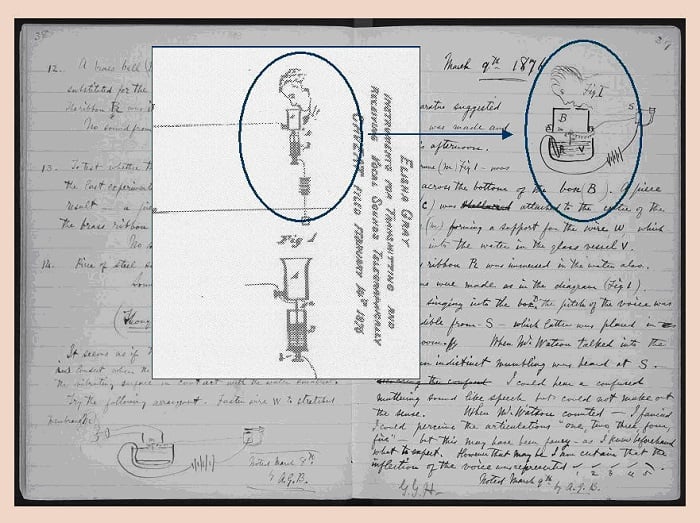Historical Engineers: Alexander Graham Bell and the First Telephone
March 3rd marks what would be the 171st birthday of Alexander Graham Bell. He is credited by many as the inventor of the telephone, but that wasn’t his only innovation.
March 3rd marks what would be the 171st birthday of Alexander Graham Bell. He is credited by many as the inventor of the telephone, but that wasn’t his only innovation.
Early Life and Career
Alexander Graham Bell was born in Scotland in 1837. His mother was hard of hearing and his father taught elocution, the study of articulating voice and speech clearly. His father's work revolved around making visible speech to help people who were deaf communicate better. This got Bell interested in the inner workings of sound at an early age. In fact, he began his career teaching deaf students and, despite owning the Bell Telephone Company (which later became AT&T), Bell still preferred to refer to himself as a "teacher of the deaf".
In 1871, Bell moved to Boston and began work on the "harmonic telegraph", which would allow for a telegraph to transmit multiple messages sent to different frequencies. While experimenting with his harmonic telegraph, Bell became enamored with the idea of transmitting human speech over wires, something most engineers at the time thought was impossible.
Bell's investors became frustrated with his side project and sent Thomas Watson, an electrician, to keep Bell focused on the harmonic telegraph. In an ironic turn of events, Watson also became enamored with Bell's idea of transmitting the human voice over wires, which created a great partnership between the two. As an electrician, Watson helped Bell bring his ideas from the realm of the abstract to real designs much faster than Bell could on his own.
Securing the Patent for the World's First Telephone
Eventually, Bell's investors began to see the potential value of the telephone and filed for a patent on the telephone on February 14th, 1876. Although Bell and Watson had yet to get their design working, this patent would prove to be crucial for Bell, who never thought of himself as much of a businessman.
The same day that Bell's investors filed for the telephone patent, Elisha Gray, who was independently developing his own telephone design, filed for a patent caveat. Bell's investors beat Gray by two hours for the patent. This has led to controversy among historians, some of whom side with Elisha Gray's later lawsuit attempts and think that Bell stole Gray's design. Fortunately for Bell and Watson, they made their first successful telephone call on March 7th, 1876, which cemented them as the device's inventors.

Elisha Gray referred to the similarities between their design as his "smoking gun", but Bell's successful demonstrations dispelled these notions. Image courtesy of the Wikimedia Commons.
After successful demonstrations of the telephone, Bell and his investors attempted to sell the patent to Western Union, who was the largest telegraph company at the time for $100,000. Western Union declined, so Bell's team moved forward with the Bell Telephone Company.
Western Union later tried to buy the patent, realizing the profit potential in telephones, but Bell refused this time around (a sort of historical parallel to when Yahoo declined Google's offer to sell to for $1 million before realizing its value). Had Western Union accepted Bell's offer, the landscape of telecom providers might look quite different today.
Alexander Graham Bell's Later Career and Life
Always more of a scientist than a businessman, Bell left running the Bell Telephone Company to his investors. He used some of the fortune he made with the telephone to start the Volta Laboratory, which was dedicated to improving the lives of the deaf.
In 1880, he turned his eye towards inventing a device that could use light to transmit sound. Although his attempts to demonstrate a "working photophone" were successful, they never became a commercial product. Bell's work on the photophone was not a total bust, his research was later continued upon and helped lead to the discovery of the Photovoltaic Effect.
He also developed an early version of a metal detector. This was inspired by doctors struggling to find a bullet in President James A Garfield's back. Although Bell's efforts couldn't save Garfield, his invention worked and was adopted in the medical field.
Bell spent his final years in Nova Scotia, where he devoted his time to studying aeronautics and was involved with the National Geographic Society.

Bell also invented a hydrofoil and set the world record for speed on a boat at the time. Image courtesy of the Free Press Journal.
He died at his estate in Nova Scotia in 1922. He held more than 18 patents at the time of his death.
Learn More About Alexander Graham Bell
There is far more to Alexander Graham Bell's life and work than I can fit in one article, so I recommend the page listed below as a starting point for further reading. The telephone patent controversy is interesting to read about, but the arguments can be hard to navigate (even for historians!). There are a lot of interesting theories about Bell stealing intellectual property to develop his telephone, but I am comfortable referring to Bell as the inventor because he was the first to successfully demonstrate the device.
- Who Invented the Telephone? An interesting layout of the patent battle from the Library of Congress along with some books listed for further reading.
If you have any interesting facts about Bell that I left out, resources for further reading, or if you've found some interesting theories about the telephone patent, please share them in the comments!







